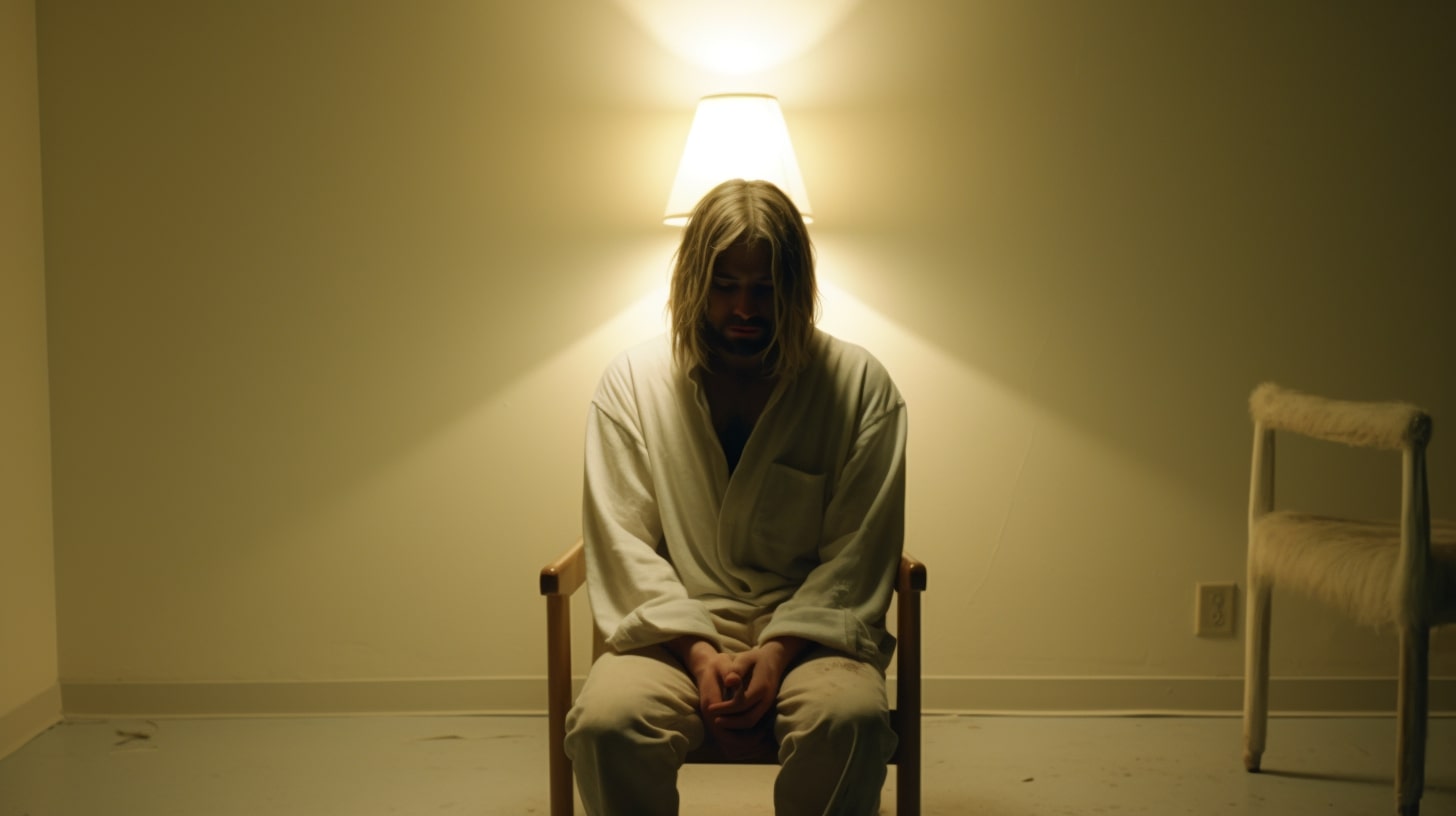Kurt Cobain, the iconic lead singer, and guitarist of the influential American rock band Nirvana, tragically died at the age of 27.
Cobain’s death remains a subject of controversy and speculation to this day, with some suggesting possible foul play or murder. Regardless of the theories surrounding his demise, Kurt Cobain’s legacy as a pioneering figure in the grunge movement and influential musician endures.
Contents
Kurt Cobain’s Life and Career
Early Life and Formation of Nirvana
Kurt Cobain, born on February 20, 1967, in Aberdeen, Washington, had a generally happy childhood until his parents divorced when he was nine years old. Influenced by punk rock, grunge rock, and alternative rock, Cobain formed the band Nirvana in 1987, together with bassist Krist Novoselic in Seattle, a city that would soon be known for the grunge music movement. Later on, Dave Grohl joined the group as a drummer, solidifying the lineup that would eventually rise to fame.
Rise to Fame and Impact on the Music Industry
Nirvana’s second album, Nevermind, was released in 1991 and propelled the band to stardom. The album’s lead single, “Smells Like Teen Spirit,” became an anthem for the disenchanted Generation X, showcasing the raw energy and emotion that would define grunge music. Nirvana, along with other bands such as Pearl Jam and Alice in Chains, had a significant impact on the music industry, challenging and changing the landscape of popular music at the time.
The band’s third and final studio album, In Utero, was released in 1993 and continued to showcase their signature sound, blending punk rock and alternative rock influences. The album received critical acclaim, further cementing their status as one of the era’s most influential bands.
Throughout his career, Cobain attracted substantial media attention, both for his personal life and his musicianship. He married Courtney Love in 1992, and the couple had a daughter, Frances Bean Cobain, later that same year. Cobain’s struggles with fame, depression, and substance abuse were well-documented, leading to speculation surrounding his untimely death.
Kurt Cobain’s impact on the music industry was felt long after his passing, with bands and artists citing his work as an inspiration for their own. Cobain’s legacy continues to influence not only grunge and alternative rock but also the wider landscape of music. His life and career, though tragically brief, left an indelible mark on both the music scene and world history.
Cobain’s Struggles with Addiction and Mental Health
Substance Abuse and Overdoses
Kurt Cobain, the lead singer, and guitarist of the rock band Nirvana, struggled with a heroin addiction throughout his career. His substance abuse began in the late 1980s and escalated in the early 1990s as Nirvana gained fame.
Cobain’s addiction led to several overdoses, one of which occurred in Rome in March 1994. During this incident, he mixed alcohol and Rohypnol, which resulted in a coma. Cobain’s substance abuse can also be traced back to his hometown of Seattle, Washington, where he reportedly used heroin and other drugs.
Depression and Stomach Pain
Apart from addiction, Cobain also struggled with mental illness, particularly depression. This was further exacerbated by the severe stomach pain he experienced for most of his life. In seeking relief from the constant pain, Cobain resorted to self-medication with alcohol and drugs. His depression may have been linked to his stomach issues or associated with the pressure of fame he endured during his career.
Courtney Love and Relationship Challenges
Cobain married Courtney Love in 1992, and they had a daughter named Frances. The couple’s relationship was tumultuous, marked by drug use and public disputes. They both faced addiction issues, which often resulted in co-dependency and constant turmoil. Their marriage was further strained by wild rumors in the press, including accusations of Love’s drug use during pregnancy and speculations about their impending divorce.
Despite their challenges, Cobain and Love remained together until his death in April 1994. As a talented musician with a complex personal life, Kurt Cobain’s tragic story demonstrates the stark impact of addiction and mental illness on an individual and their relationships.
Circumstances of Kurt Cobain’s Death
Incidents Leading Up to His Death
Kurt Cobain, the lead singer, and guitarist of the American rock band Nirvana, suffered from various health issues throughout his life, including chronic bronchitis and an undiagnosed stomach condition. These problems contributed to his struggle with depression, alcoholism, and drug addiction. In the days leading up to his death, Cobain reportedly overdosed on several drugs, including Rohypnol.
Discovery of the Suicide Note and Body
On April 8, 1994, an electrician named Gary Smith arrived at Cobain’s Seattle home to install a security system. Upon looking inside a room above the garage, he discovered Cobain’s lifeless body with a shotgun beside him. A suicide note was also found at the scene, addressed to Boddah, Cobain’s imaginary childhood friend.
The Seattle Police Department was notified, and they arrived at the scene to conduct an investigation. The note, which has since been released to the public, revealed Cobain’s thoughts on his struggles with fame and the toll it took on his mental health. He also expressed his love for his family and thanked various people in his life.
Medical Examination and Official Findings
The official cause of Cobain’s death was determined to be a self-inflicted gunshot wound to the head. A toxicology report revealed high levels of heroin and diazepam in his system at the time of his death. The Seattle Police Department concluded that Cobain had died by suicide, ruling out any possibility of foul play.
Despite the official findings, some continue to question the circumstances surrounding Cobain’s death, suggesting that it was not a suicide but rather a conspiracy involving his wife, Courtney Love. However, the overwhelming evidence supports the fact that Cobain took his own life at the age of 27.
Kurt Cobain’s Death: Conspiracy Theories and Controversies
Tom Grant’s Investigations
Tom Grant, a private investigator, has been one of the leading voices in the conspiracy theories surrounding Kurt Cobain’s death. Grant believes that Cobain was murdered and that his wife, Courtney Love, was involved in a conspiracy that resulted in the grunge star’s death. According to Grant, there are inconsistencies in the case, such as the level of heroin in Cobain’s body, which would have made it difficult for him to pull the shotgun trigger. Additionally, Grant points to the handwriting on the last few lines of the suicide note as potentially suspicious, fueling further speculation of foul play.
Soaked in Bleach Documentary
In an attempt to bring these conspiracy theories to a broader audience, a documentary titled “Soaked in Bleach” was released in 2015. The film explores Tom Grant’s investigation into Cobain’s death and presents a case for the murder theory.
This documentary features interviews with various individuals who share Grant’s skepticism, including experts in handwriting analysis, ballistics, and forensics.
While the documentary has garnered attention from fans and conspiracy theorists alike, many critics have denounced it as one-sided and exploitative.
FBI Files Release
In 2021, the FBI released a previously withheld file on Kurt Cobain, further fueling the conspiracy theories surrounding his death. The documents consisted of letters from concerned fans urging the FBI to investigate his death as a murder, citing various reasons such as discrepancies in the crime scene, the suspicious nature of Courtney Love, and possible manipulation of the private detective originally hired by Love to find Cobain.
While the FBI’s response to these letters was to affirm that they do not have jurisdiction over determining the cause of someone’s death, releasing these files has continued to stir debate and discussion among fans and conspiracy theorists.
Cobain’s Legacy and Influence
Posthumous Album Releases
After Kurt Cobain’s death, several posthumous albums have been released, featuring his previously unheard music, live performances, and demos. These releases include MTV Unplugged in New York (1994), From the Muddy Banks of the Wishkah (1996), and Nirvana (2002). These albums have helped to preserve and expand Cobain’s musical legacy, showcasing his talent and the lasting impact of his work.
Impact on Music and Popular Culture
Kurt Cobain, the frontman of Nirvana, played a significant role in shaping the music and popular culture of the early 1990s. With their raw sound and angsty lyrics, Nirvana became an emblematic band of the grunge movement, influencing countless artists across various genres. Cobain’s personal style also had a great impact on fashion trends, popularizing the “grunge” look characterized by plaid flannel shirts, torn jeans, and worn-out sneakers.
Furthermore, Cobain’s struggles with mental health and drug addiction resonated with many fans, leading to increased awareness and discussions about these issues in society.
Commemoration and Fan Tributes
Since he died in 1994, Kurt Cobain has been commemorated in various ways by fans and fellow musicians. Notably, Charles R. Cross released the biography Heavier than Heaven, providing an in-depth account of Cobain’s life and career.
Additionally, photographer John Van Hasselt took a series of iconic images widely recognized and celebrated in popular culture. Numerous tributes, such as murals and websites, have been dedicated to Cobain by fans worldwide, reflecting their continued admiration for the late rocker.
Kurt Cobain’s legacy continues to influence musicians and fans alike. His impact on music, fashion, and popular culture remains significant more than two decades after his tragic death.


